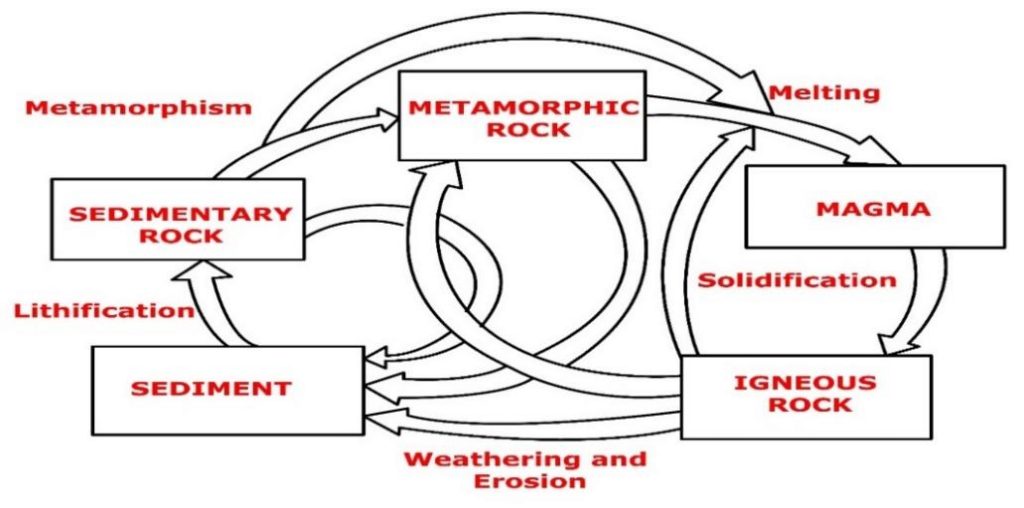Rocks
A rock is a non-living, naturally generated earth substance. Rocks are composed of mineral grains that are bound together in a solid mass. The presence of many minerals causes the various hues and textures visible in this rock. When one or two minerals aggregate, it leads to the formation of rocks. Earth is made up of rocks. Rocks have different compositions of mineral constituents. Feldspar is one of the most recurrent minerals present in rocks. Another one is quartz.
Based On Their Mode Of Formation
Igneous Rocks
- It is also known as primary rock
- The formation of igneous rock is from magma and lava
- By the upward movement, the magma cools down and turns into solid to form igneous rock( igneous – in Latin means fire)
- The igneous rocks are classified based on the size and arrangement of grains
- Sudden cooling of magma results in small and smooth grains
- The medium cooling of molten magma obtains medium sizes of grains of igneous rock
Examples of igneous rocks are
- Granite.
- Gabbro.
- Pegmatite.
- Basalt.
- Volcanic breccia .
- Tuff.
Sedimentary Rocks
- In Latin, the word ‘sedimentum’ means settling, derived from sedimentary
- Due to prolonged exposure to denudational agents, rocks are broken into various fragments
- Exogenous agents transport these rocks fragments. And get deposited in some places. By compaction, deposits turn to form rocks. This process is called lithification
- The thickness of sedimentary rocks varies by the number of layers like sandstone, shale, etc
Based on the mode of formation, it is classified into three types.
1) Mechanically formed –
- Sandstone.
- Conglomerate.
- Limestone.
- Shale, and loess, etc.
2) Organically formed-
- Geyserite.
- Chalk.
- Limestone, coal, etc.
3) Chemically formed –
- Chert.
- Limestone.
- Halite.
- Potash.
Metamorphic Rocks
- Metamorphic rocks are formed under pressure, volume, and temperature(PVT) change. The word metamorphic indicates the change of form
- During the solidification process, recrystallisation takes place within the original rock. Not only recrystallisation but also reorganisation of materials. This process is called metamorphism
- When the molten magma contacts crustal rocks or underlying rocks or when rocks are forced down to lower levels by tectonic processes, it undergoes a significant amount of pressure by underlying rocks. This process is known as metamorphism
- Dynamic Metamorphisms – Organisation of the original minerals within rocks due to breaking and crushing in the absence of chemicals. It is formed by mechanical disruption and reorganisation of rocks
Thermal Metamorphism
Thermal metamorphisms- Due to thermal metamorphism, the chemical material in the rocks get altered and recrystallised. It is of two types.
- Contact Metamorphisms – The rock materials crystallise under high temperatures. It turns into crystals when it comes in contact with hot magma and lava
- Regional Metamorphism – Rock undergoes crystallisation due to deformation caused by tectonic shearing with high temperature, pressure, or both
Some rock grains or minerals are arranged in layers or lines in the metamorphism process. This layer arrangement of minerals or grains is called foliation or lineation.
The arrangement of minerals and materials in an alternative thin and thick layer is called banding and such rocks are called banded rocks.
Foliated and Non- foliated are two significant classifications of metamorphic rocks.
Examples of metamorphic rocks are
- Gneissoid.
- Granite.
- Syenite.
- Slate.
- Schist.
- Marble.
- Quartzite.
Rock Cycle
It is one of the continuous processes. Transformation occurs in this process, where old rocks get modified into new rocks. The rock cycle basically refers to the process of cyclical transition of rocks from one form to another. Igneous rocks are formed when hot lava cools. These igneous rocks are subsequently fragmented into little particles that are transported and deposited. Sedimentary rocks are formed as a consequence of this. Moreover, mineral grains and their rock type cycle through many forms throughout the geological cycle. Temperature, pressure, time, and changes in environmental conditions in the Earth’s crust and at its surface all influence the process.
- Through the subduction process, the formation of crustal rocks(igneous, metamorphic, sedimentary rocks) may be carried down into the mantle( interior of the earth).
- Again these rocks are molten down due to an increase in temperature in the mantle and turn out into molten magma.
Conclusion:
In this unit, we have looked into what rocks exactly are, its components and its varying types. We also looked into the formation of each of these types of rocks and discussed examples. We can conclude that rocks are naturally occurring mineral substances that are quite hard in nature. Rocks may be made up of a single mineral or even a mixture of minerals that are either closely packed or bound together by a mineral matrix. Finally, igneous, sedimentary, and metamorphic rocks are the three main types of rock.

- Through the subduction process, the formation of crustal rocks(igneous rocks, metamorphic, sedimentary) may be carried down into the mantle( interior of the earth).
- Agin these rocks are molten down due to an increase in temperature in the mantle and turn out into molten magma.
 Profile
Profile Settings
Settings Refer your friends
Refer your friends Sign out
Sign out













